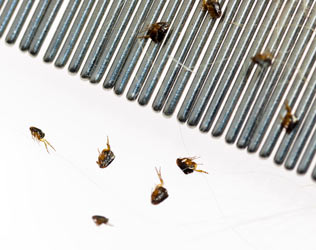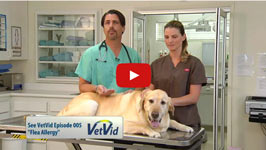Dog Fleas: How to Look for Fleas on Your Dog

Fleas are more than a nuisance; they can cause a variety of illnesses in dogs. (This article discusses those illnesses, as well as common flea control products for dogs.) The problem is that, unless they are allergic to flea saliva, dogs don't always scratch when they have fleas. To complicate matters more, fleas are wily and great at hiding. So how can you determine if your dog has fleas?
Know Where the Fleas Like to Gather
The most common congregating spot for fleas is around the base of your dog's tail and her lower back. You can certainly find them anywhere on your dog's body but if there are only a few fleas and you want the best chance of finding them, start there.
Push the Fur Backwards to Get a Better View
Fleas don't waste much time on top of your dog's fur. That isn't where their lifeblood (pardon the pun) is. They need to get down to your dog's skin in order to sink their mouthparts into their host and drink blood. The best way for you to see your dog's skin is to gently push the fur backwards with your hand.
Don't Hinge All of Your Hopes on Seeing an Actual Flea
Fleas are sneaky and there aren't always very many of them on your dog at once. You'll need to put on your detective hat and look for more than just live fleas. The other evidence that these pesky pests are nibbling on your canine pal is their excrement. They leave flea feces wherever they go.
- Flea stool impersonates small specks of black dirt, so it is called "flea dirt."
- Look for and collect any dirt that you find during your visual flea hunt and also when you search with a flea comb (see next section).
- If you take some of the dirt look-a-likes, place them on a white paper towel, sprinkle water on them, then give them a little rub, you will see red smudges appear. This is a definitive answer for you: your dog has fleas. The reason the flea dirt turns red is because it is just digested blood.
Use a Flea Comb
If you haven't spotted fleas or flea dirt at this point, grab a flea comb and run it all over your dog, stopping every swipe or two to examine the comb's tines. Look for fleas and flea dirt. Fleas can slip through the bristles of a regular brush, but a flea comb's tines are too close together for the critters to squeeze between. You can catch them this way, but be ready to put them in some soapy water or squish them really hard: they are expert escape artists and their exoskeletons are hard to crush.
So there you have it, the best ways to look for fleas on your dog. This great video from VetVid can show you the steps, too:
You May Also Like These Articles:
Dealing With Canine Scratching and Licking
Bubonic Plague: The Role of Dogs in the Spread of Plague
How to Be Prepared for Your Dog's Veterinary Bills
Lick Granuloma: Causes, Treatments, and Prevention of Acral Lick Granuloma in Dogs
Are Dogs Ticklish? Why Do Dogs Kick Their Leg When You Rub or Scratch Them?
Why Do Dogs Chase Their Tails?
Disclaimer: This website is not intended to replace professional consultation, diagnosis, or treatment by a licensed veterinarian. If you require any veterinary related advice, contact your veterinarian promptly. Information at DogHealth.com is exclusively of a general reference nature. Do not disregard veterinary advice or delay treatment as a result of accessing information at this site. Just Answer is an external service not affiliated with DogHealth.com.
Notice: Ask-a-Vet is an affiliated service for those who wish to speak with a veterinary professional about their pet's specific condition. Initially, a bot will ask questions to determine the general nature of your concern. Then, you will be transferred to a human. There is a charge for the service if you choose to connect to a veterinarian. Ask-a-Vet is not manned by the staff or owners of DogHealth.com, and the advice given should not delay or replace a visit to your veterinarian.




